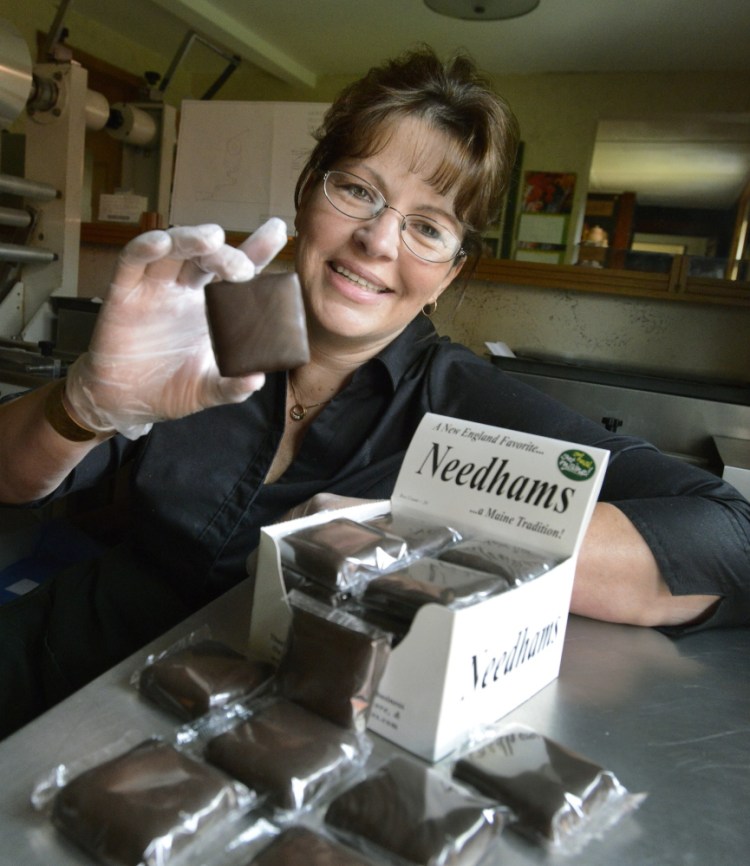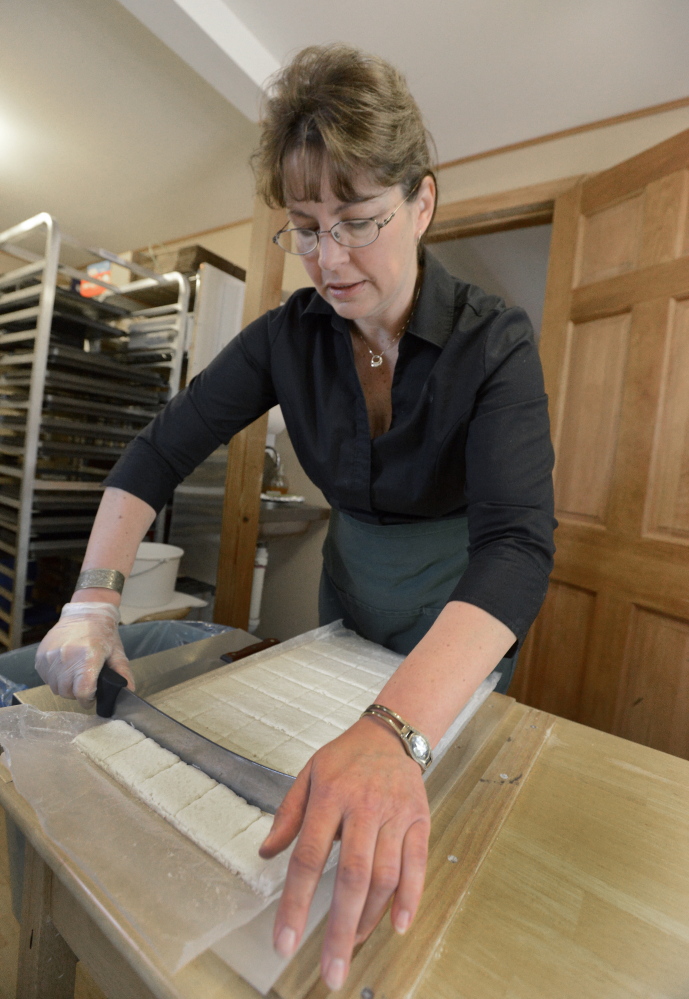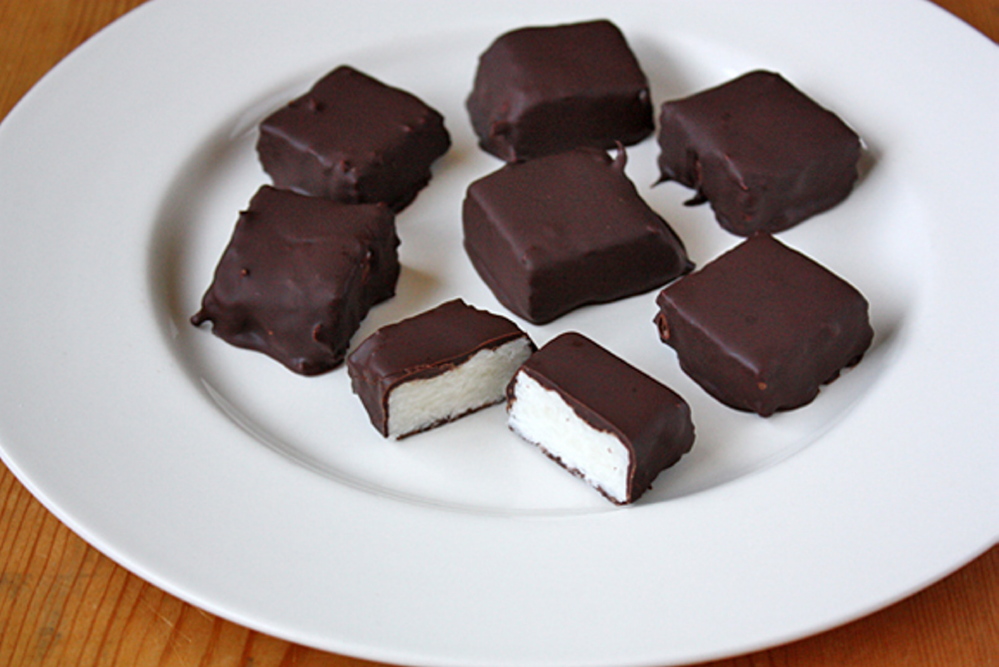NORWAY — Linda Lenberg’s modest home, tucked down a back street in this small western Maine town, smells like chocolate.
Yours would, too, if you made 2,000 needhams every week.
Needhams are coconut and potato confections dipped in chocolate. They are the less famous cousin of the whoopie pie. Although needhams have their own loyal following, they seem destined to remain in the shadow of the cream-filled cakes, now that top chefs are glamming up whoopies.
Needhams are not uppity. They are to Maine what the Goo Goo Cluster is to Tennessee. Mainers grow up finding needhams in their Christmas stockings. They are sold in gift boxes for Mother’s Day. Individually wrapped, they are one of those impulse purchases for sale beside cash registers in convenience stores.
The needham’s claim to fame is not the coconut that makes up the majority of the filling, but the bit of mashed potato that helps hold the coconut together and supposedly cuts the sweetness of the powdered sugar. Some people claim the potato is just filler, but “needhams are potato,” Lenberg says. Without it, she insists, the candy should not be called a needham.
There’s not enough potato in a needham to taste it, but the very idea of mixing potatoes with coconut and chocolate turns some people off. Lenberg’s niece’s children used to devour her imperfect seconds, until the day they heard there was potato inside them. “Now they won’t eat them.”
Finicky kids have not hurt her business. Lenberg started out selling needhams for weekend spending money about eight years ago, but now her candies (found at MaineNeedhamCompany.com) are distributed all over the state and she makes her living from them.
Lenberg (who so resembles Sarah Palin people asked her for her autograph when the Alaska politician was running for Vice President) began by making carrot cake that she sold to restaurants and convenience stores. One day a store owner who was a big fan asked her: “What else do you make? Why are you only bringing us one thing?”
The only other thing she made that her family and friends raved about was her needhams. Lenberg grew up eating needhams from Seavy’s, the now-defunct company that started making them in the late 1800s and for decades was the primary needham producer in the state. As an adult, she found an “old-fashioned recipe” and started making them herself.
IN THE BEGINNING, CROCKPOTS
Her home business began with a line of crockpots in her kitchen for melting the chocolate. She had trays of filling everywhere. The crockpots sometimes burned the chocolate, so after a while she bought a chocolate enrobing machine and put it in her bedroom. She slept in the attic.
When her son moved out, she transformed his bedroom into a tiny, incredibly efficient certified candy kitchen with the enrobing machine, a 20-quart mixer, a small sink and racks and racks of trays to hold the filling and the finished product. At first she’d wrap her finished product by hand, in little bags, and it took a couple of days to complete a batch. Now wrapping the candy takes only a couple of hours, thanks to an ancient Italian packaging machine she bought from a whoopie pie maker she met at a trade show. This, Lenberg said, led to the first of many “Lucy and Ethel moments.”
The packaging machine would only fit diagonally into her kitchen. It needed a 220-volt electrical outlet, so she unplugged her stove and plugged in the packaging machine. She remembered a box of honeybuns her daughter had stashed in a cabinet.
“I took a box out of the cupboard, and I put them on the belt, and I had no idea what was going to happen,” Lenberg recalled. “I hit the ‘on’ button, and these cakes go voom voom voom voom. They were whipping from the kitchen into (the dining room), and hitting the corner wall. It was like a baseball pitching machine. The kids were screaming, and we were cracking up.”
Lenberg sent the machine off to a group of University of Maine engineering students in Bangor, who adjusted it for her. “It cost me more to get it running than to buy it,” she said.
The machine now sits against the wall of the dining room.
Lenberg’s week begins on Monday, when she makes the filling for the candies. “The potato is the very first thing,” she said, followed by coconut oil, vanilla, salt and, finally, a lot of shredded coconut and powdered sugar. She adds a touch of preservative as well, since potato goes bad fairly quickly. A wrapped needham has a shelf life of six to eight weeks.
She cuts the trays of filling into squares on Tuesdays, then enrobes them in chocolate.
“See, this had to set up over night,” she said, wielding a long curved knife that looks like something out of an Aladdin fairy tale as she prepared to cut the filling into squares. “It’s like cookie dough minus the chocolate chips. It’s really gooey, and if you tried to run it through the machine all gooey, it would just make a big, blobby mess.”
Lenberg isn’t sure exactly how much potato goes into the candies. She thinks it’s about a cup or two per batch.
She turns on the enrober, which makes a loud chugging sound, and warms up the chocolate.
Lenberg loads the squares of filling in one end, being careful to smooth the edges with a small knife and examining them to make sure there are no loose crumbs. When crumbs interfere with the coating process, Lenberg ends up with half-coated candies.
The curtain of chocolate – Lenberg won’t say what kind she uses – falls on top of the candies while a wheel spinning underneath coats the bottoms. Then the needhams pass through a cooling panel that sets the chocolate. Commercial cooling panels cost about $20,000, Lenberg said, “and I made this one for five bucks.”
In the early days of Maine Needham Co., Lenberg’s mother sat on a stool at the end of the conveyor belt and held out a spatula to catch each needham as it came out of the cooler – which set the stage for more “Lucy and Ethel moments.” Then a friend of Lenberg’s made her a stainless steel tray that gently catches them so they glide onto the trays without breaking.
Lenberg, a perfectionist, inspects each needham a second time as it comes out of the enrober, checking to see that the bottoms are completely covered in chocolate.
Wednesday is wrapping day, a task made easier listening to Billy Joel, Elton John and Frank Sinatra on her iPod. (Sinatra is a new addition to her playlist since she started ballroom dancing.) Thursdays are taken up with distributors and invoicing. On Fridays, Lenberg makes some deliveries herself, including to Micucci’s and Free Range Fish and Lobster in Portland, before heading off to a dance.
CARRYING ON THE TRADITION
Surrounded daily by needhams and the smell of chocolate, Lenberg has tired of them and rarely eats the candies herself. “It’s sad because this was my favorite thing growing up,” she said. “We bought the Seavy’s Needhams in the one-pound box when I was a kid.”
She’s proud of carrying on the tradition, though, even if she’s not sure where it came from. Many stories exist that purport to explain the origins of needhams. The one Lenberg has heard is that an overabundance of potatoes one year in northern Maine led to a contest to see what could be done with the extras. A chocolate maker put potatoes in his chocolates. His name? Needham.
From Food.com: “They originated in Portland, Maine, by a candy maker who had attended an evangelistic service in Portland in 1872. The evangelist’s name was the Rev. George C. Needham and because of many conversions, his name was on everyone’s lips. When the candymaker came back to his shop after one of the services, his candymakers were making a new candy. When he asked the name of this candy, a young candymaker said, “Call them Needhams.”
A 1986 story in the Christian Science Monitor is very similar, including Needham the evangelist, purportedly from the town of Needham, Massachusetts. According to the Monitor, the candy was created by an employee of the well-known candy maker Mr. Seavey who asked his co-workers and employer to try it. “Approval by Mr. Seavey and the others was immediate, and the candy was added to inventory.” This story ends with Mr. Seavey naming the candies: “let’s call ’em needhams, after the popular preacher!”
The Name game
Which legend is correct? Are any?
“I’ve never seen an authenticated story” about the origin of needhams, says Maine food historian Sandra Oliver.
Oliver doubts that there was ever a year when “there were too many potatoes” in Maine.
“I find that hard to believe,” she said. “However, I could imagine a potato association, or some kind of a board, sponsoring a contest for how to use potatoes. There’s something that sounds right about that. That sort of thing happened a lot, and happened in the 20th century, primarily.”
Searching through her own library, Oliver found a 1930 American Legion auxiliary cookbook from Thomaston with a recipe for potato candy. A 1926 recipe from the First Universalist Church of Machias has a recipe for something called uncooked fudge, she said, “but when you look at a recipe, that’s a needham.”
“My instinct is that this is may have even come out of a coconut company’s test kitchen,” she said.
Needhams have mostly stayed the same over the years, but some makers do experiment with different flavors. Sue’s Needhams, which have won awards at the annual Chocolate Lover’s Fling, makes peanut butter and peppermint versions. Bayside Chocoates in Lubec makes blueberry, almond and maple-pecan needhams. Maine Needhams in Ellsworth makes almond, mint, blueberry, maple, raspberry and strawberry.
Dean Bingham, owner of Dean’s Sweets in Portland, makes a needham truffle that contains Cold River potato vodka – “the spirit of potato” – instead of mashed potatoes.
At Len Libby in Scarborough, the candy makers use 15 fresh coconuts every week to go into their needhams. They choose coconuts with lots of milk inside since they use the milk to help flavor the candy. “We have to take a hatchet and cut off all of the outer shell, and that is very time consuming,” said Gisele DeGrinney, manager of the candy store. “And then to take the coconut meat out and shred it, that’s another few hours of work. I don’t know of any other candy shop that does it like we do it.”
The Len Libby recipe using fresh coconut has not changed in 80 years. There’s another big difference between it and other recipes. Although Len Libby calls their candy a needham, it contains no potato.
“That’s like saying we make our peanut butter and jelly sandwiches without peanut butter,” Oliver said. “It can’t be done.”
Copy the Story LinkSend questions/comments to the editors.






Success. Please wait for the page to reload. If the page does not reload within 5 seconds, please refresh the page.
Enter your email and password to access comments.
Hi, to comment on stories you must . This profile is in addition to your subscription and website login.
Already have a commenting profile? .
Invalid username/password.
Please check your email to confirm and complete your registration.
Only subscribers are eligible to post comments. Please subscribe or login first for digital access. Here’s why.
Use the form below to reset your password. When you've submitted your account email, we will send an email with a reset code.